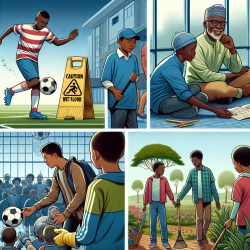Introduction
Adolescent injuries are a pressing public health issue, particularly in developing regions like sub-Saharan Africa. A recent study titled Self-reported injuries and correlates among school-going adolescents in three countries in Western sub-Saharan Africa sheds light on the prevalence and causes of injuries among school-going adolescents in Benin, Ghana, and Liberia. The findings highlight the urgent need for targeted interventions to prevent injuries and promote adolescent well-being.
Understanding the Research
The study analyzed data from the Global School-based Student Health Survey, involving 8,912 adolescents from the three countries. The results revealed a high prevalence of serious injuries, with 40.9% of adolescents reporting injuries in the past year. The most common injuries were broken bones or dislocated joints, cuts or stab wounds, and unspecified injuries. Notably, the prevalence of injuries was higher among males and increased with age.
Key Correlates of Injuries
The study identified several correlates of injuries, including interpersonal aggression, bullying victimization, physical fights, and being physically attacked. These factors significantly increased the odds of serious injuries. Additionally, lifestyle factors such as alcohol use and psychological factors like anxiety were associated with higher injury rates.
Implications for Practitioners
Practitioners working with adolescents can leverage these findings to enhance their strategies for injury prevention. Here are some actionable steps:
- Implement Anti-Bullying Programs: Schools should establish comprehensive anti-bullying policies and programs to mitigate the risk of injuries related to bullying and physical aggression.
- Promote Conflict Resolution Skills: Teaching adolescents effective conflict resolution skills can reduce the likelihood of physical fights and related injuries.
- Encourage Safe Behaviors: Practitioners should educate adolescents on the dangers of alcohol use and promote safe behaviors to prevent injuries.
- Enhance Parental Involvement: Encouraging parental monitoring and support can help reduce risky behaviors and improve adolescent safety.
Encouraging Further Research
While this study provides valuable insights, further research is needed to explore the specific environmental and cultural factors contributing to adolescent injuries in different contexts. Practitioners are encouraged to engage in research initiatives and collaborate with academic institutions to develop evidence-based interventions tailored to their communities.
Conclusion
Addressing adolescent injuries requires a multifaceted approach that considers individual, relational, and environmental factors. By implementing targeted prevention strategies and fostering a supportive environment, practitioners can significantly reduce the incidence of injuries among adolescents and promote their overall well-being.
To read the original research paper, please follow this link: Self-reported injuries and correlates among school-going adolescents in three countries in Western sub-Saharan Africa.










